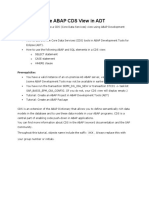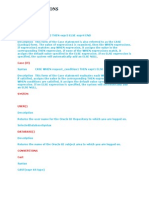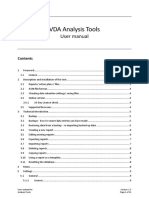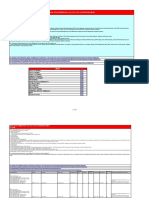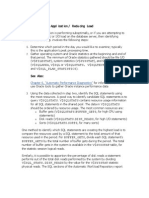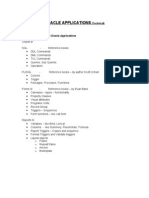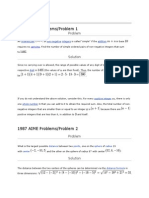100%(3)100% found this document useful (3 votes)
942 viewsObiee Admin Interview Questions
The document discusses the Oracle Business Intelligence (OBIEE) 11g architecture and components. It describes the logical architecture of an OBIEE system, including Java and non-Java components like the Administration Server, Managed Servers, Node Manager, and Fusion Middleware Control. It also covers installation types, system requirements, scaling approaches, and the use of the boot.properties file to auto-login when starting OBIEE services.
Uploaded by
NaveenVasireddyCopyright
© © All Rights Reserved
Available Formats
Download as DOCX, PDF, TXT or read online on Scribd
100%(3)100% found this document useful (3 votes)
942 viewsObiee Admin Interview Questions
The document discusses the Oracle Business Intelligence (OBIEE) 11g architecture and components. It describes the logical architecture of an OBIEE system, including Java and non-Java components like the Administration Server, Managed Servers, Node Manager, and Fusion Middleware Control. It also covers installation types, system requirements, scaling approaches, and the use of the boot.properties file to auto-login when starting OBIEE services.
Uploaded by
NaveenVasireddyCopyright
© © All Rights Reserved
Available Formats
Download as DOCX, PDF, TXT or read online on Scribd
You are on page 1/ 13
1) Obiee Architecture explanation
A) Below diagram describes the standard logical architecture of Oracle
business intelligence 11g system
The entire system architecture is called BI Domain, this BI Domain
divided into Java components and non-Java components. Java
components are weblogic server Domain components and non java
components are Oracle BI system components.
This domain consists of Managed server and Admin Server. These
services comprises mainly with all the java modules to trigger the java
services.
Admin Server: A JEE container that runs in a dedicated Java virtual
machine that contains Java components for administering the system .It
typically trigger the start, stop kind of admin activity for his peer Manager
server processes.
Managed Server:A JEE container that runs in a dedicated Java virtual
machine that provides the run-time environment for the Java-based
services and applications within the system. The services comprises of BI
plug-in, Security, publisher, SOA, BI Office services etc
Node Manager: Node Manager is a separate java utility runs to trigger the
auto start, stop, restart activities and it provides process management
services for the Admin server and Managed Server.
Oracle Process Manager and Notification Server (OPMN):By using this
OPMN services we can stop and start all system components of BI. It is
monitored, managed and controlled by Fusion Middleware Controller.
Oracle Weblogic Server (Console): It is a Java EE application server that
supports the deployment of Oracle Business Intelligence Java
components. Oracle WebLogic Server Administration Console access has
been provided by Fusion Middleware Control. Oracle WebLogic Server
Administration Console enables to monitor and
manage a WebLogic Server domain. Its capabilities include the following:
Monitoring health and performance of JEE servers Configuring WebLogic
domains Stopping and starting JEE servers Viewing JEE server logs
Fusion Middleware Control: Fusion Middleware Control is a browser-based
tool and the recommended method for monitoring, managing, and
configuring Oracle Business Intelligence components. Starting, stopping,
and restarting all system components (BI Server, BI Presentation Server)
and Managed Servers
Configuring preferences and defaults
Starting, stopping, and restarting all system components (BI Server,BI
Presentation Server) and Managed Servers
Managing performance and monitoring system metrics(DMS-Dynamic
Monitoring System)
Performing diagnostics and logging (ODL-Oracle Diagnostic
Logging)Fusion Middleware Control also provides access to Oracle
WebLogic Server Administration Console, where you monitor and manage
Oracle Business Intelligence Java components.
Java components:
Deployed as one or more Java EE applications:
Administrative Components Enterprise Management applications and
JMX MBeans for managing all configuration and run-time settings for
Oracle Business Intelligence
2) Types of Obiee installation
A)
Type of
installation
Purpose Definition
Simple Install
Demonstration and
Evaluation
Single-User
Development
Installation with the default settings
on a single computer in the minimum
number of steps
Enterprise
Install
Enterprise
Deployment
for Hosted
Development
and Production
Enterprise Install type enables you to
specify several more configuration
settings than the simple
Software Only
Install
Enterprise
Deployment
for Highest Levels
of Availability and
Security
Installation of the binary without
configuration
3) What is System Requirement and Certification metrics in Obiee?
A) Before performing any installation, you should read the system
requirements and certification documentation to ensure that your
environment meets the minimum installation requirements:
system requirements for hardware and software requirements
(minimum disk space and memory requirements, required system
libraries, packages, or patches)
certification document for supported installation types, platforms,
operating systems, databases, JDKs, and third-party products
4) What is Horizontal scaling and Vertical Scaling in Obiee 11g?
A)
Horizontal Scaling OBIEE 11g
For providing high availability and high performance in a large user base
installation we do the
scaling out of OBIEE 11g across hosts. Horizontal scaling is when the
OBIEE system components
(Bi Server, Presentation Server, OPMN, Cluster controller, java host) are
set up across n hosts
(In most cases this will be two hosts bihost1 and bihost2). Similarly
admin servers (weblogic console,
enterprise manager) and managed servers (bi plugin, bi publisher, bi
office, ws/soa) are scaled up
across n hosts (again could be just two hosts).
Thus Horizontal scaleout of BI provides for scalability and failover of a
single host.
Vertical Scaling provides for resilience and usage of spare capacity. While
configuring the clustered Bis we can provide for a failover in two
ways. Active/Active and Active/Passive.
BI Server, Bi Presentation server and Java hosts are configured for
active/active failover.
If one of the BI server fails, the session is still active, query will fail but if
we do the refresh of the browser the analysis will re-run.
If one of BI presentation server fails and the session is still active the user
will need to login again.
Cluster Controller and Bi Scheduler are configured for active/passive
failover. If one fails the secondary comes up.
Vertical Scaling OBIEE 11g
Vertical scaling in OBIEE means adding more Business Intelligence
Components to the same computer to make use of the hardware
resources. There are cases when the middleware hardware is sized with
many CPUs and more Memory, so in order to make use of them then we
have to do vertical scaling.
By default the installation gives only one process for each component.
Vertical Scaling occurs when we add additional capacity of system
components (ie additional bi servers , presentation servers and java hosts
) on the same hosts. For example, we can have two instances of
bi servers, two instances of presentation servers and two instances of
java hosts running on the
same hosts. The vertical scaling provides resilience and usage of spare
capacity.
This may not protect against the whole host failing.
Before jumping in just wanted to give a hint that by default 11g OBIEE is
a single node cluster which
can be scaled up or down very easly. A good option like 11g Database
Single Node Cluster
which can be scaled up or down when ever needed.
5) What is the use of boot.properties file in obiee 11g?
A) When we starting BI services for OBIEE 11g always the services will
prompt for Admin username and password. To avoid/fix this prompt we
have a workaround as follows.
Create a boot.properties file for the Administration Server and BI server.
This file enables the Servers to start without prompting you for the
administrator username and password.
1. Go to the following directory:
<Middleware_HOME>/user_projects/domains/bifoundation_domains/serv
ers/AdminServer/security
2. In this directory, create a file called boot.properties using a text editor
and enter the following lines in the file:
username=Admin_Username
password=Admin_Password
3. Save the file and close the editor. (Make sure that the extension of the
file should be boot.properties not boot.properties.txt)
4. Place the same boot.properties in following driectory too to start BI
server without asking username and password.
<Middleware_HOME>/user_projects/domains/bifoundation_domains/serv
ers/bi_server1/security/
Note:
When you start the Administration Server, the username and password
entries in the file get encrypted. For security reasons, you want to
minimize the time the entries in the file are left unencrypted. After you
edit the file, you should start the server as soon as possible so that the
entries get encrypted.
-------------------------------------------------------------------------------
Another answer
-------------------------------------------------------------------------------
To Configure boot.properties file for auto login while
starting/stopping OBIEE 11g
A boot.properties file contains user credentials for starting and stopping an instance of WebLogic
Server. An Administration Server can refer to this file for user credentials instead of prompting you to
provide them.
To configure the boot.properties file for the AdminServer (WebLogic), perform the following
steps:
1. Go to
$MIDDLEWARE_HOME/user_projects/domains/bifoundation_domain/servers/AdminServers/security
and create the boot.properties file.
vi boot.properties
2. add the below values in a file and save it.
username=admin_username
password=admin_password
eg:
username=weblogic
password=weblogic1
3. Now go to $MIDDLEWARE_HOME/user_projects/domains/bifoundation_domain/bin and run Admin
server in nohup mode
nohup ./startWebLogic.sh >startWebLogic.log &
You can check in the log that it's using boot.properties file for login credentials.
eg:
/scratch/home/mw1/user_projects/domains/bifoundation_domain/servers/AdminServer/security/boot.p
roperties>
Nov 28, 2012 11:40:25 PM oracle.ods.virtualization.engine.util.VDELogger info
INFO: Notification sent for Mapping config object reloaded
and also username and password will be encrypted automatically once admin server is started using
boot.properties file. Samething with managed server
eg:
-bash-4.1$ cat boot.properties
#Wed Nov 28 23:39:59 PST 2012
password={AES}KzE36wWcZfXJ riP/ctNLXyiJ 7XhGliErrE3Hd9WJ yj4\=
username={AES}L/OMSXhRReONiUV+ts45J E7uM5IZ+WAjSbhBNsG6xH8\=
-bash-4.1$ pwd
/scratch/home/mw1/user_projects/domains/bifoundation_domain/servers/AdminServer/security
To configure the boot.properties file for the Managed Server, perform the following steps:
1. Go to
$MIDDLEWARE_HOME/user_projects/domains/bifoundation_domain/servers/bi_server1/security and
create the boot.properties file.
vi boot.properties
2. add the below values in a file and save it.
username=admin_username
password=admin_password
eg:
username=weblogic
password=weblogic1
3. Now go to $MIDDLEWARE_HOME/user_projects/domains/bifoundation_domain/bin and run
managed server in nohup mode.
nohup ./startManagedWebLogic.sh bi_server1 >startManagedWebLogic.log &
6) How to start and stop obiee services?
A)
1.Stop opmnctl
Navigate to
<MiddlewareHome>/instances/instance1/bin
./opmnctl stopall
2.Stop Managed Server (bi_server1)
Navigate to
<MiddlewareHome>/user_projects/domains/bifoundation_domain/bin
./stopManagedWebLogic.sh bi_server1
3.Stop Admin Server (weblogic)
in the same above location
./stopWebLogic.sh
4.Stop Node manger
Just kill the Node Manager process
ps -ef|grep node to find nodemanger pid
kill -9 <nodemanager_pid>
Note: If Managed and Admin server not stopped properly ,you can kill
same way like above
ps -ef|grep weblogic
kill -9 <pid>
Start Services:
======================
1.Start Node Manager
Navigate to <MiddlewareHome>/wlserver_10.3/server/bin
nohup sh startNodeManager.sh &
2.Start Admin Server
Navigate to
<MiddlewareHome>/user_projects/domains/bifoundation_domain/bin
nohup sh startWebLogic.sh -
Dweblogic.management.username=weblogic -
Dweblogic.management.password=weblogic123 > admin_server.log
&
Tip: you can check log using tail command
tail -f admin_server.log
ctrl-z or ctrl-c to exit log window
3.Start Managed Server (bi_server1)
In the same above location
nohup sh startManagedWebLogic.sh bi_server1
http://<host_name>:7001 > managed_server.log &
4. Start opmnctl
Navigate to <MiddlewareHome>/instances/instance1/bin
./opmnctl startall
7) Directory Structure of Obiee11g
A)
MW_HOME : MiddleWare directory e.g. D:\OBIEE11G
WL_HOME : MW_HOME\wlserver_10.3\
DOMAIN_HOME : MW_HOME\user_projects\domains\bifoundation_domain\
ORACLE_INSTANCE : MW_HOME\instance\instance1
OBIEE 11g - Important Path Directories
Start BI Services (parameter: start_all)
..\\\instances\instance1\bifoundation\OracleBIApplication\coreapplication\
StartStopServices.cmd start_all
Stop BI Services (parameter: stop_all)
..\\\instances\instance1\bifoundation\OracleBIApplication\coreapplication\
StartStopServices.cmd stop_all
Sample Application Data and Repository
..\\\instances\instance1\bifoundation\OracleBIServerComponent\coreappli
cation_obis1\sample
BI Repository(RPD)
..\\\instances\instance1\bifoundation\OracleBIServerComponent\coreappli
cation_obis1\repository
Usage tracking and Marketing Segmentation Scripts
..\\\instances\instance1\bifoundation\OracleBIServerComponent\coreappli
cation_obis1\schema
BI Server Cache file
..\\\instances\instance1\bifoundation\OracleBIServerComponent\coreappli
cation_obis1\cache
BI Presentation Catalog
..\\\instances\instance1\bifoundation\OracleBIPresentationServicesCompo
nent\coreapplication_obips1\catalog
Clustered Component
..\\\instances\instance1\bifoundation\OracleBIClusterControllerComponen
t\coreapplication_obiccs1
Scheduler Components (Scheduler schema etc.)
..\\\instances\instance1\bifoundation\OracleBISchedulerComponent\corea
pplication_obisch1
BI ODBC , Javahost and other components
..\\\instances\instance1\bifoundation
Start Weblogic Server (startWebLogic.cmd)
..\\\user_projects\domains\bifoundation_domain
BI Config Files
..\\\instances\instance1\config
Repository Config files (NQSConfig.INI,DBFeatures.INI etc)
..\\\instances\instance1\config\OracleBIServerComponent\coreapplication
_obis1
Catalog config files(instanceconfig.xml,credentialstore.xml etc)
..\\\instances\instance1\config\OracleBIPresentationServicesComponent\c
oreapplication_obips1
Scheduler Catalog config files (instanceconfig.xml)
..\\\instances\instance1\config\OracleBISchedulerComponent\coreapplicat
ion_obisch1
Cluster Config files
..\\\instances\instance1\config\OracleBIApplication\coreapplication
OPMN Startup (parameter: startall)
..\\\instances\instance1\bin opmnctl startall
OPMN Stop (parameter: stopall)
..\\\instances\instance1\bin opmnctl stopall
BI PATH Initialisation
..\\\instances\instance1\bifoundation\OracleBIApplication\coreapplication\
setup\bi-init.cmd
Weblogic Admin and Managed Server start/stop
scripts(startWebLogic.cmd,startManagedWebLogic.cmd etc.)
..\\\user_projects\domains\bifoundation_domain\bin
BIPublisher repository and Config files
..\\\user_projects\domains\bifoundation_domain\config\bipublisher
FMW Security Config files (system-jazn-data.xml)
..\\\user_projects\domains\bifoundation_domain\config\fmwconfig
BI Components Log files
..\\\instances\instance1\diagnostics\logs
BI Server Log files (NQserver.log , NQQuery.log etc.)
..\\\instances\instance1\diagnostics\logs\OracleBIServerComponent\core
application_obis1
BI Presentation Server Log files (sawlog)
..\\\instances\instance1\diagnostics\logs\OracleBIPresentationServicesCo
mponent\coreapplication_obips1
Installation Log files
..\\\logs
Boot.properties:
/apps/biadmin/Oracle/user_projects/domains/bifoundation_domain/server
s/AdminServer/security
Application
Role:/apps/biadmin/OBIEE11g/user_projects/domains/bifoundation_doma
in/config/fmwconfig
CustomSkin:
/apps/biadmin/OBIEE11g/user_projects/domains/bifoundation_domain/se
rvers/bi_server1/tmp/_WL_user/analyt
ics_11.1.1/7dezjl/war/res
TNS path:
C:\app\user\product\11.2.0\dbhome_1\NETWORK\ADMIN
\Oracle_BI1\network\admin
\oracle_common\network\admin
8) Obiee Log Files Locations
A)
Important
1. Admin Server (Or weblogic server issues)
\user_projects\domains\bifoundation_domain\servers\AdminServer\logs
2. Managed Server
\user_projects\domains\bifoundation_domain\servers\bi_server1\logs\
3. BI Server
\OBI11G\instance\instance1\diagnostics\logs\OracleBIServerComponent\coreapplication_obis1
4. BI Persentation Server:
\OBI11G\instance\instance1\diagnostics\logs\OracleBIPresentationServicesComponent\coreapplication_obips1
Log File Name Physical Path
Installation log <OBIEE_HOME>/logs
NQQuery Log
<OBIEE_HOME>/instances/instance1/diagnostics/logs/OracleBIServerCo
mponent/coreapplication_obis1
NQSServer Log
<OBIEE_HOME>/instances/instance1/diagnostics/logs/OracleBIServerCo
mponent/coreapplication_obis1
ServerName_NQSAdminTool Log
<OBIEE_HOME>/instances/instance1/diagnostics/logs/OracleBIServerCo
mponent/coreapplication_obis1
ServerName_NQSUDMLExec log
<OBIEE_HOME>/instances/instance1/diagnostics/logs/OracleBIServerCo
mponent/coreapplication_obis1
servername_obieerpdmigrateutillog (Migration log)
<OBIEE_HOME>/instances/instance1/diagnostics/logs/OracleBIServerCo
mponent/coreapplication_obis1
sawlog0 log (presentation)
<OBIEE_HOME>/instances/instance1/diagnostics/logs/OracleBIPresentati
onServicesComponent/coreapplication_obips1
JH log (Java Host)
<OBIEE_HOME>/instances/instance1/diagnostics/logs/OracleBIJavaHostC
omponent\coreapplication_obijh
WebcatUpgrade Log (WebCatalog Upgrade)
<OBIEE_HOME>/instances/instance1/diagnostics/logs/OracleBIPresentati
onServicesComponent/coreapplication_obips1
NQScheduler Log (Agents)
<OBIEE_HOME>/instances/instance1/diagnostics/logsOracleBISchedulerC
omponent/coreapplication_obisch1
NQCluster Log
<OBIEE_HOME>/instances/instance1/diagnostics/logs/OracleBIClusterCo
ntrollerComponent\coreapplication_obiccs1
ODBC log
<OBIEE_HOME>/instances/instance1/diagnostics/logs/OracleBIODBCCom
ponent/coreapplication_obips1
OPMN Log
<OBIEE_HOME>/instances/instance1/diagnostics/logs/OPMN/opmn
Debug log
<OBIEE_HOME>/instances/instance1/diagnostics/logs/OPMN/opmn
LogQuery log
<OBIEE_HOME>/instances/instance1/diagnostics/logs/OPMN/opmn
Service log
<OBIEE_HOME>/instances/instance1/diagnostics/logs/OPMN/opmn
OPMN Out
<OBIEE_HOME>/instances/instance1/diagnostics/logs/OPMN/opmn
Upgrade Assistant log <OBIEE_HOME>Oracle_BI1/upgrade/logs
9) Obiee config Files locations?
A)
1. NQSConfig.INI and logconfig.xml
\OBI11G\instances\instance1\config\OracleBIServerComponent\coreapplication_obis1
2. instanceconfig.xml
\instances\instance1\config\OracleBIPresentationServicesComponent\coreapplication_obi
ps1
3. ClusterConfig.xml
ccslogging.xml
\instances\instance1\config\OracleBIApplication\coreapplication
4. instanceconfig.xml (Second instanceconfig.xml dedicated file for BI Scheduler)
\instances\instance1\config\OracleBISchedulerComponent\coreapplication_obisch1
5. config.xml and logging_config.xml
\instances\instance1\config\OracleBIJavaHostComponent\coreapplication_obijh1
6. bridgeconfig.properties (For BI Persentation services Plug-in)
\OBI11G\user_projects\domains\bifoundation_domain\config\fmwconfig\biinstances\cor
eapplication
7. opmn.xml (OPMN Config file)
/OBI11G/instance/instance1/config/OPMN/opmn/opmn.xml
(It contains the PATH and LD_LIBRARY_PATH values for the system components and the
port number for OPMN and optional SSL configuration.)
8. boot.properties
/OBI11G/user_projects/domains/bifoundation_domain/servers/[managed_server]/securi
ty
You might also like
- Hourglass Workout Program by Luisagiuliet 276% (21)Hourglass Workout Program by Luisagiuliet 251 pages
- The Hold Me Tight Workbook - Dr. Sue Johnson100% (16)The Hold Me Tight Workbook - Dr. Sue Johnson187 pages
- Read People Like A Book by Patrick King-Edited62% (65)Read People Like A Book by Patrick King-Edited12 pages
- Livingood, Blake - Livingood Daily Your 21-Day Guide To Experience Real Health77% (13)Livingood, Blake - Livingood Daily Your 21-Day Guide To Experience Real Health260 pages
- COSMIC CONSCIOUSNESS OF HUMANITY - PROBLEMS OF NEW COSMOGONY (V.P.Kaznacheev,. Л. V. Trofimov.)94% (212)COSMIC CONSCIOUSNESS OF HUMANITY - PROBLEMS OF NEW COSMOGONY (V.P.Kaznacheev,. Л. V. Trofimov.)212 pages
- Donald Trump & Jeffrey Epstein Rape Lawsuit and Affidavits83% (1016)Donald Trump & Jeffrey Epstein Rape Lawsuit and Affidavits13 pages
- The 36 Questions That Lead To Love - The New York Times94% (34)The 36 Questions That Lead To Love - The New York Times3 pages
- The 36 Questions That Lead To Love - The New York Times95% (21)The 36 Questions That Lead To Love - The New York Times3 pages
- Jeffrey Epstein39s Little Black Book Unredacted PDF75% (12)Jeffrey Epstein39s Little Black Book Unredacted PDF95 pages
- The 4 Hour Workweek, Expanded and Updated by Timothy Ferriss - Excerpt23% (954)The 4 Hour Workweek, Expanded and Updated by Timothy Ferriss - Excerpt38 pages
- Oracle Database Administration Interview Questions You'll Most Likely Be Asked: Job Interview Questions SeriesFrom EverandOracle Database Administration Interview Questions You'll Most Likely Be Asked: Job Interview Questions Series5/5 (1)
- OBIA 11.1.1.7.1 With ODI Step by Step Installation and ConfigurationNo ratings yetOBIA 11.1.1.7.1 With ODI Step by Step Installation and Configuration34 pages
- ODI 11g Master and Work Repository Creation Steps - 1No ratings yetODI 11g Master and Work Repository Creation Steps - 120 pages
- ConfiguringHighAvailability BIApplications11.1.1.8.1 Doc ID 1679319.1No ratings yetConfiguringHighAvailability BIApplications11.1.1.8.1 Doc ID 1679319.15 pages
- Configuring ODI Studio and BI Client Tools.: Copy "Biee - Client - Install - X64.exe" File (From Linux)No ratings yetConfiguring ODI Studio and BI Client Tools.: Copy "Biee - Client - Install - X64.exe" File (From Linux)22 pages
- Making The Move From Oracle Warehouse Builder To Oracle Data Integrator 12No ratings yetMaking The Move From Oracle Warehouse Builder To Oracle Data Integrator 1219 pages
- Security - Authentication and AuthorizationNo ratings yetSecurity - Authentication and Authorization22 pages
- Complete Installation and Configuration of Oracle Data IntegratorNo ratings yetComplete Installation and Configuration of Oracle Data Integrator33 pages
- Oracle Fusion Middleware 12c (12.2.1.2.0+) Certification MatrixNo ratings yetOracle Fusion Middleware 12c (12.2.1.2.0+) Certification Matrix42 pages
- Chapter 6, "Automatic Performance Diagnostics"No ratings yetChapter 6, "Automatic Performance Diagnostics"7 pages
- EBS OBIEE Integration White Paper V2 1 PDFNo ratings yetEBS OBIEE Integration White Paper V2 1 PDF11 pages
- Making The Move From Oracle Warehouse Builder To Oracle Data Integrator 12cNo ratings yetMaking The Move From Oracle Warehouse Builder To Oracle Data Integrator 12c34 pages
- Oracle Interview Questions:: Company: Interview Type: ZOOM Meeting Date: Interview Time: 45 HoursNo ratings yetOracle Interview Questions:: Company: Interview Type: ZOOM Meeting Date: Interview Time: 45 Hours3 pages
- Oracle 1z0 083 Dumps by Stephens 24-05-2024 7qa BraindumpscollectionNo ratings yetOracle 1z0 083 Dumps by Stephens 24-05-2024 7qa Braindumpscollection9 pages
- OBIEE - Dashboard Tips and Best Practice GuidelinesNo ratings yetOBIEE - Dashboard Tips and Best Practice Guidelines6 pages
- 1z0 434 Oraclesoasuite12cessentials Blogspot Pe 2015-12-1z0No ratings yet1z0 434 Oraclesoasuite12cessentials Blogspot Pe 2015-12-1z030 pages
- Oracle Cloud Infrastructure 2024 Generative AI Professional 1Z0-1127-24 Practice Exam Questions GitHubNo ratings yetOracle Cloud Infrastructure 2024 Generative AI Professional 1Z0-1127-24 Practice Exam Questions GitHub1 page
- Oracle E-Business Suite Manufacturing & Supply Chain ManagementFrom EverandOracle E-Business Suite Manufacturing & Supply Chain ManagementNo ratings yet
- Oracle BI Solutions - OBIEE 11g - Supports 2 Kinds of Clustering Vertical and HorizontalNo ratings yetOracle BI Solutions - OBIEE 11g - Supports 2 Kinds of Clustering Vertical and Horizontal6 pages
- Oracle BI Solutions - OBIEE 11g - Supports 2 Kinds of Clustering Vertical and HorizontalNo ratings yetOracle BI Solutions - OBIEE 11g - Supports 2 Kinds of Clustering Vertical and Horizontal6 pages
- IIT Maths Aime Problem Solving by Naveen Vasireddy100% (2)IIT Maths Aime Problem Solving by Naveen Vasireddy842 pages
- Hi Friends This Is My 1 Book Read It AllNo ratings yetHi Friends This Is My 1 Book Read It All1 page
- SAP Add-On Installation Tool SAINT PhasesNo ratings yetSAP Add-On Installation Tool SAINT Phases4 pages
- Making The Best of Application Security Solutions: Amit Ashbel Product EvangelistNo ratings yetMaking The Best of Application Security Solutions: Amit Ashbel Product Evangelist47 pages
- Livingood, Blake - Livingood Daily Your 21-Day Guide To Experience Real HealthLivingood, Blake - Livingood Daily Your 21-Day Guide To Experience Real Health
- COSMIC CONSCIOUSNESS OF HUMANITY - PROBLEMS OF NEW COSMOGONY (V.P.Kaznacheev,. Л. V. Trofimov.)COSMIC CONSCIOUSNESS OF HUMANITY - PROBLEMS OF NEW COSMOGONY (V.P.Kaznacheev,. Л. V. Trofimov.)
- Donald Trump & Jeffrey Epstein Rape Lawsuit and AffidavitsDonald Trump & Jeffrey Epstein Rape Lawsuit and Affidavits
- The 36 Questions That Lead To Love - The New York TimesThe 36 Questions That Lead To Love - The New York Times
- The 36 Questions That Lead To Love - The New York TimesThe 36 Questions That Lead To Love - The New York Times
- Jeffrey Epstein39s Little Black Book Unredacted PDFJeffrey Epstein39s Little Black Book Unredacted PDF
- The 4 Hour Workweek, Expanded and Updated by Timothy Ferriss - ExcerptThe 4 Hour Workweek, Expanded and Updated by Timothy Ferriss - Excerpt
- Oracle Database Administration Interview Questions You'll Most Likely Be Asked: Job Interview Questions SeriesFrom EverandOracle Database Administration Interview Questions You'll Most Likely Be Asked: Job Interview Questions Series
- OBIA 11.1.1.7.1 With ODI Step by Step Installation and ConfigurationOBIA 11.1.1.7.1 With ODI Step by Step Installation and Configuration
- ODI 11g Master and Work Repository Creation Steps - 1ODI 11g Master and Work Repository Creation Steps - 1
- ConfiguringHighAvailability BIApplications11.1.1.8.1 Doc ID 1679319.1ConfiguringHighAvailability BIApplications11.1.1.8.1 Doc ID 1679319.1
- Configuring ODI Studio and BI Client Tools.: Copy "Biee - Client - Install - X64.exe" File (From Linux)Configuring ODI Studio and BI Client Tools.: Copy "Biee - Client - Install - X64.exe" File (From Linux)
- Oracle SOA BPEL Process Manager 11gR1 A Hands-on TutorialFrom EverandOracle SOA BPEL Process Manager 11gR1 A Hands-on Tutorial
- Oracle SOA Suite 11g Administrator's HandbookFrom EverandOracle SOA Suite 11g Administrator's Handbook
- Oracle Recovery Appliance Handbook: An Insider’S InsightFrom EverandOracle Recovery Appliance Handbook: An Insider’S Insight
- Making The Move From Oracle Warehouse Builder To Oracle Data Integrator 12Making The Move From Oracle Warehouse Builder To Oracle Data Integrator 12
- Complete Installation and Configuration of Oracle Data IntegratorComplete Installation and Configuration of Oracle Data Integrator
- Oracle Fusion Middleware 12c (12.2.1.2.0+) Certification MatrixOracle Fusion Middleware 12c (12.2.1.2.0+) Certification Matrix
- Making The Move From Oracle Warehouse Builder To Oracle Data Integrator 12cMaking The Move From Oracle Warehouse Builder To Oracle Data Integrator 12c
- Oracle Interview Questions:: Company: Interview Type: ZOOM Meeting Date: Interview Time: 45 HoursOracle Interview Questions:: Company: Interview Type: ZOOM Meeting Date: Interview Time: 45 Hours
- Oracle 1z0 083 Dumps by Stephens 24-05-2024 7qa BraindumpscollectionOracle 1z0 083 Dumps by Stephens 24-05-2024 7qa Braindumpscollection
- OBIEE - Dashboard Tips and Best Practice GuidelinesOBIEE - Dashboard Tips and Best Practice Guidelines
- 1z0 434 Oraclesoasuite12cessentials Blogspot Pe 2015-12-1z01z0 434 Oraclesoasuite12cessentials Blogspot Pe 2015-12-1z0
- Oracle Cloud Infrastructure 2024 Generative AI Professional 1Z0-1127-24 Practice Exam Questions GitHubOracle Cloud Infrastructure 2024 Generative AI Professional 1Z0-1127-24 Practice Exam Questions GitHub
- Oracle E-Business Suite Manufacturing & Supply Chain ManagementFrom EverandOracle E-Business Suite Manufacturing & Supply Chain Management
- Oracle Data Guard A Clear and Concise ReferenceFrom EverandOracle Data Guard A Clear and Concise Reference
- Oracle BI Solutions - OBIEE 11g - Supports 2 Kinds of Clustering Vertical and HorizontalOracle BI Solutions - OBIEE 11g - Supports 2 Kinds of Clustering Vertical and Horizontal
- Oracle BI Solutions - OBIEE 11g - Supports 2 Kinds of Clustering Vertical and HorizontalOracle BI Solutions - OBIEE 11g - Supports 2 Kinds of Clustering Vertical and Horizontal
- IIT Maths Aime Problem Solving by Naveen VasireddyIIT Maths Aime Problem Solving by Naveen Vasireddy
- Making The Best of Application Security Solutions: Amit Ashbel Product EvangelistMaking The Best of Application Security Solutions: Amit Ashbel Product Evangelist
































